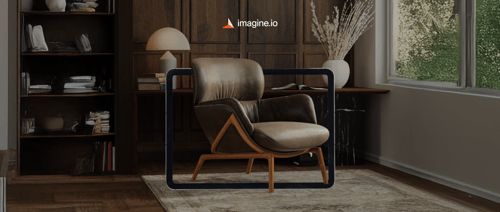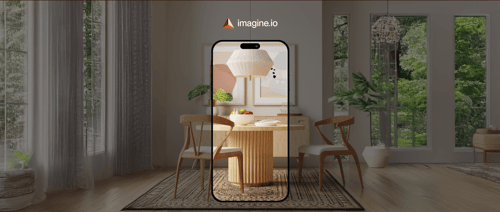Lifestyle photography creates emotional connections that drive home goods purchases. Styled images help buyers visualize products in their spaces, leading to higher conversion rates and increased sales.
Quick Listen:
Imagine you're browsing an online home goods store, searching for a dining table that feels just right. You come across a crisp image of a table against a plain white backdrop. It's clean, professional, but it leaves you cold does it fit your space? Can you picture holiday dinners around it? Now, envision that same table in a warm, sunlit dining room, set with elegant plates, surrounded by laughter and life. That's the magic of lifestyle photography. It doesn't just display a product; it tells a story that pulls you in, making you want to bring that moment home. In the booming world of home decor, where the global market hit $747.75 billion in 2024 and is projected to reach $1,097.51 billion by 2032, visuals like these are redefining how consumers shop.
Visuals Shape the Home Goods Experience
In eCommerce, where physical touch isn't an option, images are the bridge between a product and its buyer. Shoppers can't run their hands over a velvet sofa or test the heft of a ceramic lamp, so they lean on visuals to fill in the gaps. But a product shot alone detached, sterile rarely sparks desire. Lifestyle photography steps in here, placing items in relatable settings that evoke emotion and aspiration. It's about showing a rug in a cozy living room or a vase on a bustling kitchen counter, helping buyers imagine these pieces in their own lives.
The data underscores this shift. The home decor market, valued at $747.75 billion in 2024, is expected to grow to $802.26 billion in 2025 and climb to $1,097.51 billion by 2032, with a steady 4.58% annual growth rate. Asia Pacific held a commanding 45.74% market share in 2024, while the U.S. market is forecasted to reach $305.51 billion by 2032. This growth is fueled by consumers who demand more than specs they want visuals that inspire trust and connection.
The Evolution of eCommerce Imagery
From Static Shots to Stories
The days of plain product images ruling online retail are over. Today's shoppers crave immersive experiences that go beyond the item itself. They want to see how a chair fits into a modern loft or how a throw blanket softens a bedroom's vibe. Lifestyle photography delivers this by weaving products into narratives think a coffee table styled for a Sunday brunch or a lamp casting a warm glow over a late-night reading nook. This storytelling approach makes products feel accessible and desirable.
3D Visualization Redefines Possibilities
Enter AI-powered tools like those from imagine.io. These platforms are transforming how brands create lifestyle imagery, offering photorealistic renders without the need for costly photoshoots. With features like virtual room setups, customizable lighting, and multi-surface textures, retailers can craft scenes that resonate with diverse audiences. Whether it's a minimalist Scandinavian aesthetic or a bold, eclectic vibe, 3D visualization ensures scalability and precision, keeping visuals fresh and relevant.
Driving Sales Through Real-World Context
Case Study: Small Brand, Big Impact
Consider a small furniture brand struggling to compete with industry giants. By replacing flat product images with 3D-generated lifestyle visuals imagine a sleek sofa in a vibrant, lived-in space the brand saw engagement soar threefold in A/B tests. Why? Shoppers could visualize the sofa in their own homes, not as an isolated object but as part of a lifestyle. This shift from static to contextual imagery boosted click-through rates and conversions, proving that context is king.
Personalization Through Visual Configurators
Retailers are also embracing visual configurators, tools that let customers see products in their own spaces. Picture a shopper uploading a photo of their living room and virtually placing a sectional in it, tweaking fabrics and colors in real time. These tools, powered by platforms like imagine.io, reduce uncertainty and build confidence, directly impacting purchase decisions. By offering this level of personalization, brands not only increase sales but also cut down on returns, as customers know exactly what they're getting.
Navigating Challenges in Lifestyle Photography
The Pitfall of Inauthentic Imagery
Not every lifestyle image hits the mark. Generic stock photos, while budget-friendly, often lack the authenticity shoppers crave. As noted in a piece by Robert Lowdon, today's consumers are savvy, quickly spotting inauthentic visuals that feel staged or disconnected. A coffee table in a setting that screams “stock photo” can alienate buyers, making the product seem less trustworthy or relatable.
Consistency Across Platforms
Another challenge is maintaining visual consistency across channels. Shoppers browse on websites, mobile apps, and marketplaces like Amazon, expecting a seamless experience. If a lamp looks vibrant online but dull in a marketplace listing, it can confuse or deter buyers. Brands must ensure their lifestyle imagery remains cohesive, reinforcing their identity and building trust no matter where customers shop.
Seizing Opportunities with 3D Rendering
Cost Efficiency Without Compromise
Traditional photoshoots are a logistical nightmare staging, lighting, and re-shoots can cost thousands and take weeks. 3D lifestyle rendering, like that offered by imagine.io, eliminates these hurdles. Brands can create high-quality, customized scenes without physical sets, slashing production costs while maintaining visual excellence. This approach allows smaller brands to compete with industry leaders, delivering polished imagery on a budget.
Speeding Up Market Readiness
In a fast-moving market, timing is everything. 3D tools enable brands to produce tailored visuals for seasonal campaigns or new product launches in hours, not months. Need a cozy autumn scene for a throw blanket? Render it overnight. This agility keeps brands ahead of trends, ensuring their visuals align with consumer desires, from bohemian chic to modern minimalism.
The Buyer Journey: Trust and Emotional Resonance
Fostering Confidence and Connection
Lifestyle photography isn't just about aesthetics it's a trust-building tool. A well-crafted image of a dining set in a lively family setting conveys quality, functionality, and ambiance, all critical for high-stakes purchases like furniture. Shoppers aren't just buying a table; they're investing in memories of shared meals and celebrations. These visuals create an emotional pull that specs sheets can't match.
Reducing Returns, Boosting Sales
Clear, contextual visuals also minimize post-purchase regret. When shoppers can see exactly how a product fits into their space, they're less likely to face surprises upon delivery. This clarity drives confident purchases, reducing return rates and boosting customer satisfaction. For retailers, it's a direct path to higher margins and happier customers.
The Future of Home Goods Visuals
Lifestyle photography is no longer a nice-to-have it's a must for home goods brands aiming to thrive in a competitive market. As a visual merchandising expert recently noted, “Great imagery doesn't just sell products; it sells possibilities.” With the home decor market on track to hit $1,097.51 billion by 2032, brands leveraging AI-driven tools like imagine.io are poised to lead. From virtual showrooms to hyper-personalized visuals, the future is about creating experiences that feel personal, authentic, and inspiring.
Frequently Asked Questions
Why do lifestyle photos work better than regular product images for home goods?
Lifestyle photos help customers visualize how furniture and decor will look in their actual living spaces, creating an emotional connection that plain product shots can't achieve. When shoppers see a dining table set for a family meal rather than isolated on a white background, they can imagine hosting their own gatherings, which significantly increases purchase confidence and reduces return rates.
How can small home goods brands compete with larger retailers using lifestyle photography?
Small brands can leverage AI-powered 3D rendering tools to create professional lifestyle imagery without expensive photoshoots, allowing them to produce high-quality visuals at a fraction of traditional costs. These platforms enable brands to generate photorealistic scenes with customizable settings, lighting, and textures, helping smaller retailers create compelling visual content that rivals industry giants while staying within budget.
What impact does lifestyle photography have on eCommerce sales and returns?
Lifestyle photography significantly boosts engagement and conversion rates with some brands seeing threefold increases in A/B tests while simultaneously reducing return rates by helping customers make more informed purchasing decisions. When shoppers can clearly see how products fit into real-world settings, they experience fewer surprises upon delivery, leading to higher customer satisfaction and improved profit margins for retailers.
Disclaimer: The above helpful resources content contains personal opinions and experiences. The information provided is for general knowledge and does not constitute professional advice.
You may also be interested in: 3D Lifestyle Imagery – imagine.io
Struggling with expensive, outdated product visuals that slow down your creative process and stunt eCommerce growth? imagine.io's AI-powered platform empowers furniture, home décor, and textile brands to effortlessly produce striking 3D images, immersive videos, AR experiences, and interactive configurators. Cut production costs up to 70%, boost conversions 5X, speed up prototyping, and supercharge your online sales. Ready to elevate your product visuals and captivate customers? Book a demo with imagine.io today!
Powered by flareAI.co




.png?width=500&name=How%20to%20Add%20a%203D%20Product%20Configurator%20to%20Your%20WordPress%20Website%20(Complete%20B2B%20Guide).png)
















%20(1).png?width=500&name=Why%20Exploded%20Mattress%20Views%20Matter%20(And%20How%20to%20Generate%20Them)%20(1).png)
.png?width=500&name=Best%20Shopify%20Product%20Configurator_%20How%20to%20Choose%20the%20Right%20One%20(2).png)
.png?width=500&name=Why%20Exploded%20Mattress%20Views%20Matter%20(And%20How%20to%20Generate%20Them).png)



.png?width=500&name=Best%20Shopify%20Product%20Configurator_%20How%20to%20Choose%20the%20Right%20One%20(1).png)







.png?width=500&name=How%203D%20Rendering%20Can%20Make%20or%20Break%20Your%20Industrial%20Design%20Pitch%20(1).png)








%20with%20Digital%20Twins%20and%203D%20Visualization.png?width=500&name=Optimizing%20Your%20Digital%20Asset%20Management%20(DAM)%20with%20Digital%20Twins%20and%203D%20Visualization.png)




.png?width=500&name=Styling%20Home%20Decor%20for%202025_%20From%20Global%20Influences%20to%20Playful%20Personalization%20(1).png)
